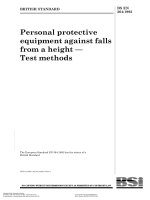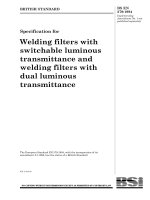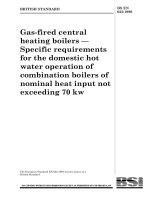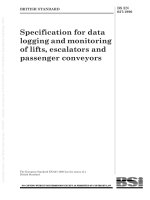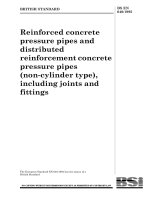Bsi bs en 62053 31 1999
Bạn đang xem bản rút gọn của tài liệu. Xem và tải ngay bản đầy đủ của tài liệu tại đây (450.03 KB, 18 trang )
BRITISH STANDARD
Electricity metering
equipment (a.c.) —
Particular
requirements —
Part 31: Pulse output devices for
electromechanical and electronic
meters (two wires only)
The European Standard EN 62053-61:1998 has the status of a
British Standard
ICS 91.140.50
BS EN
62053-31:1999
IEC
62053-31:1998
BS EN 62053-31:1999
National foreword
This British Standard is the English language version of EN 62053-31:1998. It
is identical with IEC 62053-31:1998.
The UK participation in its preparation was entrusted to Technical Committee
PEL/13, Electricity meters, which has the responsibility to:
— aid enquirers to understand the text;
— present to the responsible international/European committee any
enquiries on the interpretation, or proposals for change, and keep the UK
interests informed;
— monitor related international and European developments and
promulgate them in the UK.
A list of organizations represented on this committee can be obtained on
request to its secretary.
From 1 January 1997, all IEC publications have the number 60000 added to
the old number. For instance, IEC 27-1 has been renumbered as IEC 60027-1.
For a period of time during the change over from one numbering system to the
other, publications may contain identifiers from both systems.
Cross-references
Attention is drawn to the fact that CEN and CENELEC standards normally
include an annex which lists normative references to international
publications with their corresponding European publications. The British
Standards which implement these international or European publications may
be found in the BSI Standards Catalogue under the section entitled
“International Standards Correspondence Index”, or by using the “Find”
facility of the BSI Standards Electronic Catalogue.
A British Standard does not purport to include all the necessary provisions of
a contract. Users of British Standards are responsible for their correct
application.
Compliance with a British Standard does not of itself confer immunity
from legal obligations.
Summary of pages
This document comprises a front cover, an inside front cover, pages i and ii,
the EN title page, pages 2 to 12 and a back cover.
This standard has been updated (see copyright date) and may have had
amendments incorporated. This will be indicated in the amendment table on
the inside front cover.
This British Standard, having
been prepared under the
direction of the Electrotechnical
Sector Committee, was
published under the authority
of the Standards Committee
and comes
into effect on
15 January 1999
© BSI 05-1999
ISBN 0 580 32039 1
Amendments issued since publication
Amd. No.
Date
Comments
BS EN 62053-31:1999
Contents
National foreword
Foreword
Text of EN 62053-31
© BSI 05-1999
Page
Inside front cover
2
3
i
ii
blank
EUROPEAN STANDARD
EN 62053-31
NORME EUROPÉENNE
April 1998
EUROPÄISCHE NORM
ICS 31.140.50
Descriptors: Electricity metering, pulse output device, induction meter, static meter
English version
Electricity metering equipment (a.c.)
Particular requirements
Part 31: Pulse output devices for electromechanical and
electronic meters (two wires only)
(IEC 62053-31:1998)
Equipement de comptage de l’électricité
(c.a.) — Prescriptions particulières
Partie 31: Dispositifs de sortie
d’impulsions pour compteurs
électromécaniques et électroniques
(seulement deux fils)
(CEI 62053-31:1998)
Einrichtungen zur Messung der
elektrischen Energie (AC)
Besondere Anforderungen
Teil 31: Impulseinrichtungen für
Induktionszähler und elektronische
Zähler (nur Zweidrahtsysteme)
(IEC 62053-31:1998)
This European Standard was approved by CENELEC on 1998-04-01.
CENELEC members are bound to comply with the CEN/CENELEC Internal
Regulations which stipulate the conditions for giving this European Standard
the status of a national standard without any alteration.
Up-to-date lists and bibliographical references concerning such national
standards may be obtained on application to the Central Secretariat or to any
CENELEC member.
This European Standard exists in three official versions (English, French,
German). A version in any other language made by translation under the
responsibility of a CENELEC member into its own language and notified to the
Central Secretariat has the same status as the official versions.
CENELEC members are the national electrotechnical committees of Austria,
Belgium, Czech Republic, Denmark, Finland, France, Germany, Greece,
Iceland, Ireland, Italy, Luxembourg, Netherlands, Norway, Portugal, Spain,
Sweden, Switzerland and United Kingdom.
CENELEC
European Committee for Electrotechnical Standardization
Comité Européen de Normalisation Electrotechnique
Europäisches Komitee für Elektrotechnische Normung
Central Secretariat: rue de Stassart 35, B-1050 Brussels
© 1998 CENELEC — All rights of exploitation in any form and by any means reserved worldwide for
CENELEC members.
Ref. No. EN 62053-31:1998 E
EN 62053-31:1998
Foreword
The text of document 13/1134/FDIS, future
edition 1 of IEC 61393, prepared by IEC TC 13,
Equipment for electrical energy measurement and
load control, was submitted to the IEC-CENELEC
parallel vote. The document was published by IEC
as IEC 62053-31 and was approved by CENELEC
as EN 62053-31 on 1998-04-01.
The following dates were fixed:
— latest date by which the
EN has to be implemented
at national level by
publication of an identical
national standard or by
endorsement
(dop) 1999-01-01
— latest date by which the
national standards
conflicting with the EN
have to be withdrawn
(dow) 2001-01-01
Annexes designated “normative” are part of the
body of the standard.
Annexes designated “informative” are given for
information only.
In this standard, Annex A, Annex B, Annex C and
Annex ZA are normative and Annex D, Annex E and
Annex F are informative.
Annex ZA has been added by CENELEC.
Endorsement notice
The text of the International Standard
IEC 62053-31:1998 was approved by CENELEC as
a European Standard without any modification.
Contents
Foreword
Introduction
1
Scope
2
Normative references
3
Definitions
3.1 General definitions
3.2 Definitions related to functional
elements
4
Requirements
4.1 Functional requirements
4.2 Mechanical requirements
4.3 Climatic conditions
4.4 Electrical requirements
4.5 Electromagnetic compatibility (EMC)
2
Page
2
3
3
3
3
3
5
5.1
5.2
5.3
5.4
5.5
Tests and test conditions
General testing procedures
Tests for mechanical requirements
Tests for climatic influences
Tests for electrical requirements
Tests for electromagnetic compatibility
(EMC)
5.6 Functional tests
Annex A (normative) Physical interface of
the pulse output
Annex B (normative) Output pulse waveform
Annex C (normative) Test of pulse output
device
Annex D (informative) Test of pulse input
device
Annex E (informative) Special application —
Pulse output device for long distances
according to IEC 60381-1
Annex F (informative) Test schedule
Annex ZA (normative) Normative references
to international publications with their
corresponding European publications
Figure A.1 — Physical interface of the
pulse output
Figure B.1 — Output pulse waveform
Figure C.1 — Pulse output device test set-up
Figure D.1 — Pulse input device test set-up
Figure E.1 — Output pulse waveform
Figure E.2 — Pulse output device test set-up
Figure E.3 — Pulse input device test set-up
Table 1 — Specified operating conditions
Table C.1 — Test of pulse output device
Table D.1 — Test of pulse input device
Table E.1 — Specified operating conditions
Table E.2 — Test of pulse output device
Table E.3 — Test of pulse input device
Page
5
5
5
5
5
5
5
6
6
7
7
8
11
12
6
6
7
7
9
9
10
4
7
7
8
10
10
3
3
3
4
4
4
5
© BSI 05-1999
EN 62053-31:1998
Introduction
3.2 Definitions related to functional elements
This International Standard has been prepared to
complete the existing standards on electric energy
meters with a standard for integrated pulse output
devices.
This standard specifies a class A and class B pulse
output device. For special applications see Annex E.
3.2.1
pulse
1 Scope
This part of IEC 62053 is applicable to passive,
two-wire, externally powered pulse output devices
to be used in electricity meters as defined by the
relevant standards of technical committee 13
(see normative references) as well as future
standards for static VA-hour meters.
Such pulse output devices are used to transmit
pulses, representing a finite energy quantity, to a
receiver (e.g. a tariff device).
2 Normative references
The following normative documents contain
provisions which, through reference in this text,
constitute provisions of this part of IEC 62053. At
the time of publication, the editions indicated were
valid. All normative documents are subject to
revision, and parties to agreements based on this
part of IEC 62053 are encouraged to investigate the
possibility of applying the most recent editions of
the normative documents indicated below. Members
of IEC and ISO maintain registers of currently valid
International Standards.
IEC 60145:1963, Var-hour (reactive energy) meters.
IEC 60381-1:1982, Analogue signals for process
control systems — Part 1: Direct current signals.
IEC 60521:1988, Classes 0,5, 1 and 2
alternating-current watt-hour meters.
IEC 60687:1992, Alternating current static
watt-hour meters for active energy (classes 0,2 S
and 0,5 S).
IEC 61036:1996, Alternating current static
watt-hour meters for active energy (classes 1 and 2).
IEC 61268:1995, Alternating current static var-hour
meters for reactive energy (classes 2 and 3).
IEC 61899:1997, Static electric energy meters —
Power consumption and voltage requirements —
Multi-energy and multi-function meters.
3 Definitions
For the purpose of this International Standard, the
following definitions apply.
wave that departs from an initial level for a limited
duration of time and ultimately returns to the
original level
3.2.2
pulse device (for electricity metering)
functional unit for emitting, transmitting,
retransmitting or receiving electric pulses,
representing finite quantities, such as energy
normally transmitted from some form of electricity
meter to a receiver unit
3.2.3
pulse input device (pulse input)
pulse device for receiving pulses
3.2.4
pulse output device (pulse output)
pulse device for emitting pulses
4 Requirements
Meters equipped with pulse output devices shall
comply with all the requirements of the relevant
meter standard, unless otherwise specified in the
present standard.
4.1 Functional requirements
4.1.1 Introduction
The output pulse is characterized by two states:
ON-state and OFF-state, as defined in Table 1.
Each ON-state and each OFF-state is followed by a
transient state before reaching the other state.
Two types of pulse output devices are defined in this
standard:
— pulse output devices class A for long range
transmission;
— pulse output devices class B for short range
and low power consumption.
The pulse output shall generate a number of pulses
proportional to the measured energy.
4.1.2 Electrical environment
The physical interface of the pulse output device is
described in Annex A.
The supply source for the output circuit shall
originate from an external device (e.g. multi-rate
unit) or other selected source.
The main electrical characteristics are summarized
in Table 1.
3.1 General definitions
See in the relevant meter standard.
© BSI 05-1999
3
EN 62053-31:1998
Table 1 — Specified operating conditions
Parameters
Class A pulse device
Class B pulse device
Maximum voltage (Umax)
27 V d.c.
15 V d.c.
Maximum current in ON-state
27 mA
15 mA
Minimum current in ON-state
10 mA
2 mA
Maximum current in OFF-state
2 mA
0,15 mA
NOTE 1 The maximum distance of transmission is dependent on the environment and the quality of the cable, and must be defined
specifically.
NOTE 2 If other functions like detection of fraud, short circuit or open circuit in the transmission line, etc. are required, a solution
with the values specified in Annex E may be used.
4.1.3 Pulse characteristics
4.4 Electrical requirements
4.1.3.1 Output pulse waveform
4.4.1 Interaction with the meter
The pulses shall have the shape shown in
Figure B.1.
In order to ascertain that the pulse output device
has no adverse influence on the meter and the meter
has no adverse influence on the pulse output device,
the tests of the following clauses and subclauses
shall be carried out and the requirements met,
unless otherwise specified in this standard:
— clause 6 “Electrical requirements” and
clause 8 “Accuracy” of IEC 60145;
— clause 6 “Electrical requirements”, clause 8
“Accuracy”, clause 9 “Starting and running with
no load” and clause 10 “Adjustment” of
IEC 60521;
— subclauses 4.4 “Electrical requirements”
and 4.6 “Accuracy requirements” of IEC 60687,
IEC 61036 and IEC 61268.
4.1.3.2 Supply polarity
When the meter is equipped with several pulse
outputs that have a common terminal this common
terminal shall be negative.
4.1.3.3 Pulse duration
The pulse duration tON is defined in Figure B.1 with
tON $ 30 ms.
The time between two successive pulses tOFF is
defined in Figure B.1 with tOFF $ 30 ms.
4.1.3.4 Transition time (tT)
The transition time (rise time or fall time) is the
time from one state to the other, including transient
effects, e.g. contact bounce. The transition time
shall be less than 5 ms (see Figure B.1).
4.2 Mechanical requirements
4.2.1 General
The features of the pulse device shall comply with
all mechanical requirements stated in the standard
applying to the meter in which it is included. Refer
to the appropriate standard.
4.4.2 Power consumption
For static meters and electromechanical meters
equipped with pulse output devices, the power
consumption shall not exceed the values specified in
Table 1 of IEC 61899 for multi-function meters.
4.4.3 Influence of supply voltage
4.4.3.1 Voltage range
Refer to IEC 61036.
4.2.2 Marking of the pulse value
4.4.3.2 Voltage dips and short interruptions
Information on the pulse value in the
form x (energy units)/imp or x imp/(energy units)
shall be added on the meter name plate or on a
separate plate (imp = pulse).
4.3 Climatic conditions
Voltage dips and short interruptions shall not cause
more than one pulse. When the voltage is restored
the pulse output device shall not have suffered
degradation of its characteristics.
For testing see 5.4.1.
Refer to IEC 61036.
4.4.4 Insulation
The pulse output device shall withstand the impulse
voltage test and the a.c. voltage test, as specified
in 5.4.6 of IEC 61036.
4
© BSI 05-1999
EN 62053-31:1998
4.5 Electromagnetic compatibility (EMC)
4.5.1 Immunity to electromagnetic disturbance
The pulse output device shall be designed in such a
way that conducted or radiated electromagnetic
disturbance as well as electrostatic discharge do not
damage or substantially influence the pulse output
device or the meter in which it is included.
For testing see 5.5.1 to 5.5.4.
4.5.2 Suppression of radio interference
Meters equipped with pulse output devices shall not
generate conducted or radiated noise which can
interfere with other equipment.
For testing, see 5.5.5.
5 Tests and test conditions
5.1 General testing procedures
5.1.1 Test conditions
All tests shall be carried out under reference
conditions unless otherwise stated in the relevant
subclause.
5.1.2 Type test
The type test defined in 3.7.1 of IEC 61036 shall be
made on one or more meters, equipped with a pulse
output device selected by the manufacturer, to
establish its specific characteristics and prove its
conformity with the requirements of this standard.
A recommended test sequence is given in Annex F.
5.2 Tests for mechanical requirements
The tests shall be carried out on pulse output
devices built into the appropriate meter. After the
shock test and vibration test carried out as specified
in IEC 61036, the pulse output devices shall fulfil
the requirements for the meter under test.
5.3 Tests for climatic influences
The following tests as specified in IEC 61036 shall
be carried out: 5.3.1 dry heat test, 5.3.2 cold test
and 5.3.3 damp heat cyclic test.
After each of the climatic tests, the meter, including
the pulse output device, shall show no damage or
modification of information and shall operate
correctly.
5.5 Tests for electromagnetic
compatibility (EMC)
The tests shall be conducted on the meter including
the pulse output device. The pulse output device
shall be energized accordingly. After the tests the
pulse output device shall fulfil the same
requirements as specified in subclauses 5.5.2
to 5.5.5 for the test output of the meter.
5.5.1 General test conditions
For all these tests the meter, equipped with a pulse
output device, shall be in its normal working
position with the cover and terminal covers in place.
All parts intended to be earthed shall be earthed.
The effective length of the output leads shall not
exceed 1 m.
After these tests the pulse output device shall show
no damage and operate correctly.
5.5.2 Tests for immunity to electrostatic
discharge
The test shall be carried out according to 5.5.2 of
IEC 61036.
5.5.3 Tests for immunity to electromagnetic HF
fields
The test shall be carried out according to 5.5.3 of
IEC 61036.
5.5.4 Tests for fast transient burst
The test shall be carried out according to 5.5.4 of
IEC 61036.
5.5.5 Suppression of radio interference
The test shall be carried out according to 5.5.5 of
IEC 61036.
5.6 Functional tests
The tests shall be carried out with the same
reference conditions as the meter.
Within the operating range the pulse output device
shall operate correctly with regards to the number
of pulses emitted, and the times tON and tOFF shall
remain within their specifed range.
The test arrangement shall be according to
Annex C.
5.4 Tests for electrical requirements
5.4.1 Tests for the effect of voltage dips and
short interruptions
The tests shall be carried out as per 5.4.2.1 of
IEC 61036. For requirements see 4.4.3.2.
5.4.2 Tests for insulation properties
No additional test is required with respect to those
normally conducted for the meter itself.
© BSI 05-1999
5
EN 62053-31:1998
Annex A (normative)
Physical interface of the pulse output
Figure A.1 — Physical interface of the pulse output
Annex B (normative)
Output pulse waveform
Figure B.1 — Output pulse waveform
6
© BSI 05-1999
EN 62053-31:1998
Annex C (normative)
Test of pulse output device
The test set-up is according to Figure C.1.
Figure C.1 — Pulse output device test set-up
The pulse output device shall fulfil the requirements of the following table.
Table C.1 — Test of pulse output device
Test conditions
State of
pulse
output
Test results
Power supply
voltage (UB)
Power supply internal
resistance (Ri)
Loop current (I)
Voltage (U)
V
k7
mA
V
Class A
Class B
Class A
Class B
Class A
Class B
Class A
Class B
ON
18
3
1
$ 10
$2
#8
#1
OFF
27
15
1
#2
# 0,15
$ 25
$ 14
Annex D (informative)
Test of pulse input device
The test set-up is according to Figure D.1.
Figure D.1 — Pulse input device test set-up
The pulse input device shall fulfil the requirements of the following table.
Table D.1 — Test of pulse input device
Switch position
Resistance value
Remarks
Test results;
loop current or voltage
Class A
1
R1 = 800 7
Pulse input power supply
2
R2 # 1 7
Short-circuit current of pulse I < 27 mA
input device
I < 15 mA
3
R3 > 1 M7
Open-circuit voltage of pulse U # 27 V
input device
U # 15 V
© BSI 05-1999
I $ 10 mA
Class B
I $ 2 mA
7
EN 62053-31:1998
Annex E (informative)
Special application — Pulse output device for long distances according to
IEC 60381-1
E.1 Specified operating conditions and output pulse waveform
The main electrical characteristics are summarized in the following table.
Table E.1 — Specified operating conditions
Parameters
Minimum
Maximum
Open circuit (Io)
0 mA
< 4 mA
Rest (OFF) (Ir)
4 mA
< 6,5 mA
Defraudation (Id)
6,5 mA
< 8,9 mA
Measure pulse (ON) (Ip)
8,9 mA
< 11,4 mA
Defraudation + Measure pulse (Idp)
11,4 mA
< 14 mA
Short circuit (Is)
14 mA
20 mA
Power supply voltage
20 V
30 V
Pulse duration (tON)
30 ms
120 ms
Rise time and fall time (tT)
—
# 5 ms
Load impedance (Ri)
—
# 300 7
Distance
8
100 m
© BSI 05-1999
EN 62053-31:1998
Figure E.1 — Output pulse waveform
E.2 Test of pulse output device
The test set-up is according to Figure E.2.
Figure E.2 — Pulse output device test set-up
© BSI 05-1999
9
EN 62053-31:1998
The pulse output device shall fulfil the requirements of the following table.
Table E.2 — Test of pulse output device
Test conditions
State of pulse output
Test results
Power supply
voltage (UB)
Power supply internal
resistance (Ri)
Loop current
(I)
V
7
mA
Open circuit
20 to 30
226
0#I<4
Rest (OFF)
20 to 30
226
4 # I < 6,5
Defraudation
20 to 30
226
6,5 # I < 8,9
Measure pulse (ON)
20 to 30
226
8,9 # I < 11,4
Defraudation + Measure pulse
20 to 30
226
11,4 # I < 14
Short circuit
20 to 30
226
14 # I < 20
E.3 Test of pulse input device
The test set-up is according to Figure E.3.
Figure E.3 — Pulse input device test set-up
The pulse input device shall fulfil the requirements of the following table.
Table E.3 — Test of pulse input device
Switch position
Resistance value
Remarks
Test results; loop current
or voltage
1
R1 = 2 k7
Pulse
2
R2 # 1 7
Short circuit
14 # Is < 20 mA
3
R3 > 1 M7
Open circuit
0 # Io < 4 mA
U < 30 V d.c.
4
R4 = 4 k7
Rest
4 # Ir < 6,5 mA
5
R5 = 3 k7
Defraudation
6,5 # Id < 8,9 mA
6
R6 = 1,7 k7
Pulse + Defraudation
11,4 # Idp < 14 mA
10
8,9 # Ip < 11,4 mA
© BSI 05-1999
EN 62053-31:1998
Annex F (informative)
Test schedule
Recommended test sequence
No.
Tests
Subclause
1
Tests of insulation properties
5.4.2
2
Functional tests
5.6
3
Tests for electrical requirements
3.1
4
Tests for the effect of voltage dips and short interruptions
5.4.1
Tests for electromagnetic compatibility
4.1
Suppression of radio interference
5.5.5
4.2
Tests for fast transient burst
5.5.4
4.3
Test for immunity to electromagnetic HF fields
5.5.3
4.4
Test for immunity to electrostatic discharge
5.5.2
5
Test for climatic influences
5.3
6
Tests for mechanical requirements
5.2
© BSI 05-1999
11
EN 62053-31:1998
Annex ZA (normative)
Normative references to international publications with their corresponding
European publications
This European Standard incorporates by dated or undated reference, provisions from other publications.
These normative references are cited at the appropriate places in the text and the publications are listed
hereafter. For dated references, subsequent amendments to or revisions of any of these publications apply
to this European Standard only when incorporated in it by amendment or revision. For undated references
the latest edition of the publication referred to applies (including amendments).
NOTE When an international publication has been modified by common modifications, indicated by (mod), the relevant EN/HD
applies.
Publication
Year
Title
EN/HD
Year
IEC 60145
1963
Var-hour (reactive energy) meters
—
—
IEC 60381-1
1982
Analogue signals for process control systems
Part 1: Direct current signals
HD 452.1 S1
1984
IEC 60521
1988
Class 0,5, 1 and 2 alternating-current
watt-hour meters
EN 60521
1995
+ corr. December 1997
IEC 60687
1992
Alternating current static watt-hour meters
for active energy (classes 0,2 S and 0,5 S)
EN 60687
+ corr. March
1992
1993
IEC 61036
1996
Alternating current static watt-hour meters for
active energy (classes 1 and 2)
EN 61036
1996
IEC 61268
1995
Alternating current static var-hour meters for
reactive energy (classes 2 and 3)
EN 61268
1996
IEC 62053-61a
1998
Electricity metering equipment (a.c.) Particular
requirements
Part 61: Power consumption and voltage
requirements
EN 62053-61
1998
a
This document was voted as prEN 61899.
12
© BSI 05-1999
blank
13
BS EN
62053-31:1999
IEC
62053-31:1998
BSI — British Standards Institution
BSI is the independent national body responsible for preparing
British Standards. It presents the UK view on standards in Europe and at the
international level. It is incorporated by Royal Charter.
Revisions
British Standards are updated by amendment or revision. Users of
British Standards should make sure that they possess the latest amendments or
editions.
It is the constant aim of BSI to improve the quality of our products and services.
We would be grateful if anyone finding an inaccuracy or ambiguity while using
this British Standard would inform the Secretary of the technical committee
responsible, the identity of which can be found on the inside front cover.
Tel: 020 8996 9000. Fax: 020 8996 7400.
BSI offers members an individual updating service called PLUS which ensures
that subscribers automatically receive the latest editions of standards.
Buying standards
Orders for all BSI, international and foreign standards publications should be
addressed to Customer Services. Tel: 020 8996 9001. Fax: 020 8996 7001.
In response to orders for international standards, it is BSI policy to supply the
BSI implementation of those that have been published as British Standards,
unless otherwise requested.
Information on standards
BSI provides a wide range of information on national, European and
international standards through its Library and its Technical Help to Exporters
Service. Various BSI electronic information services are also available which give
details on all its products and services. Contact the Information Centre.
Tel: 020 8996 7111. Fax: 020 8996 7048.
Subscribing members of BSI are kept up to date with standards developments
and receive substantial discounts on the purchase price of standards. For details
of these and other benefits contact Membership Administration.
Tel: 020 8996 7002. Fax: 020 8996 7001.
Copyright
Copyright subsists in all BSI publications. BSI also holds the copyright, in the
UK, of the publications of the internationalstandardization bodies. Except as
permitted under the Copyright, Designs and Patents Act 1988 no extract may be
reproduced, stored in a retrieval system or transmitted in any form or by any
means – electronic, photocopying, recording or otherwise – without prior written
permission from BSI.
This does not preclude the free use, in the course of implementing the standard,
of necessary details such as symbols, and size, type or grade designations. If these
details are to be used for any other purpose than implementation then the prior
written permission of BSI must be obtained.
BSI
389 Chiswick High Road
London
W4 4AL
If permission is granted, the terms may include royalty payments or a licensing
agreement. Details and advice can be obtained from the Copyright Manager.
Tel: 020 8996 7070.
